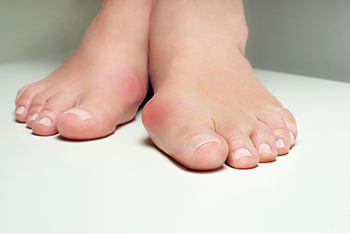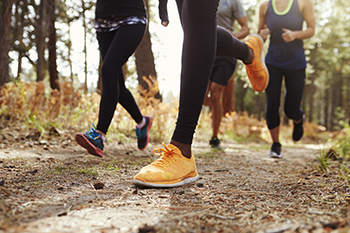February 2023
Morton’s Neuroma Symptoms

Morton’s neuroma is one particular kind of affliction of the foot that negatively impacts the health of one’s feet. Specifically, Morton’s neuroma develops when the tissue surrounding a nerve in the toes of the feet becomes thickened. As a result, pain may ensue. In fact, the primary symptom that is associated with this condition is actually pain and feelings of discomfort. Interestingly, the pain associated with this condition is not always consistent in duration. For example, sometimes the pain from Morton’s Neuroma may be intermittent. This specific kind of pain is sometimes described as comparable to standing on a marble. As a consequence of the pain, the toes might even begin to feel tingly or numb. If you are someone that has Morton’s neuroma and wants to address the pain, it is suggested that you contact a podiatrist today for treatment and assistance.
Morton’s neuroma is a very uncomfortable condition to live with. If you think you have Morton’s neuroma, contact one of our podiatrists of Advanced Foot & Ankle Associates, PLLC. Our doctors will attend to all of your foot care needs and answer any of your related questions.
Morton’s Neuroma
Morton's neuroma is a painful foot condition that commonly affects the areas between the second and third or third and fourth toe, although other areas of the foot are also susceptible. Morton’s neuroma is caused by an inflamed nerve in the foot that is being squeezed and aggravated by surrounding bones.
What Increases the Chances of Having Morton’s Neuroma?
- Ill-fitting high heels or shoes that add pressure to the toe or foot
- Jogging, running or any sport that involves constant impact to the foot
- Flat feet, bunions, and any other foot deformities
Morton’s neuroma is a very treatable condition. Orthotics and shoe inserts can often be used to alleviate the pain on the forefront of the feet. In more severe cases, corticosteroids can also be prescribed. In order to figure out the best treatment for your neuroma, it’s recommended to seek the care of a podiatrist who can diagnose your condition and provide different treatment options.
If you have any questions, please feel free to contact one of our offices located in Lake Worth and Aledo/Willow Park, TX . We offer the newest diagnostic and treatment technologies for all your foot care needs.
Mild and Severe Fractures Can Require Different Treatments

A car accident, a sporting mishap, or a fall are the leading causes of broken ankles. They can range from severe to a hairline fracture, and they can require different forms of treatment. Most people who have broken their ankle often get an X-ray. This is generally successful in determining how severe the fracture is and deciding the type of treatment that will work. Wearing a boot or cast is a common form of treatment for mild breaks, and more severe breaks may require surgery for proper healing. Many broken ankles can bruise and swell, and frequently elevating the foot may reduce these symptoms. The toes may become stiff, and wiggling them may help them to feel better. Crutches may be used to walk and complete daily tasks while taking the weight off of the feet. If you have fallen and have ankle pain, please consult with a podiatrist who can properly diagnose and offer you the treatment option that is best for you.
Broken ankles need immediate treatment. If you are seeking treatment, contact one of our podiatrists from Advanced Foot & Ankle Associates, PLLC. Our doctors can provide the care you need to keep you pain-free and on your feet.
Broken Ankles
A broken ankle is experienced when a person fractures their tibia or fibula in the lower leg and ankle area. Both of these bones are attached at the bottom of the leg and combine to form what we know to be our ankle.
When a physician is referring to a break of the ankle, he or she is usually referring to a break in the area where the tibia and fibula are joined to create our ankle joint. Ankles are more prone to fractures because the ankle is an area that suffers a lot of pressure and stress. There are some obvious signs when a person experiences a fractured ankle, and the following symptoms may be present.
Symptoms of a Fractured Ankle
- Excessive pain when the area is touched or when any pressure is placed on the ankle
- Swelling around the area
- Bruising of the area
- Area appears to be deformed
If you suspect an ankle fracture, it is recommended to seek treatment as soon as possible. The sooner you have your podiatrist diagnose the fracture, the quicker you’ll be on the way towards recovery.
If you have any questions, please feel free to contact one of our offices located in Lake Worth and Aledo/Willow Park, TX . We offer the newest diagnostic and treatment technologies for all your foot care needs.
Bunion Pain

A bunion, or hallux valgus, results from one of the bones in the big toe shifting out of position towards the smaller toes and causing a lump to form on the outside of the toe. These can be painless or cause a significant deformity causing severe pain and interfering with daily activities. A bunionette is a similar but smaller lump on the pinky toe. Calluses, corns, and redness can form over the bunions due to repeated friction. Bunions happen from wearing shoes that are too tight, a genetic predisposition to them, or a combination of these factors. These can get worse over time if left untreated. Since bunion pain is worse when wearing shoes, it is important to find shoes that have a wide enough toe box that allows the toes to move. If you have bunion problems, consult with a podiatrist who can suggest treatment options that can increase your comfort.
If you are suffering from bunion pain, contact one of our podiatrists of Advanced Foot & Ankle Associates, PLLC. Our doctors can provide the care you need to keep you pain-free and on your feet.
What Is a Bunion?
Bunions are painful bony bumps that usually develop on the inside of the foot at the joint of the big toe. As the deformity increases over time, it may become painful to walk and wear shoes. Women are more likely to exacerbate existing bunions since they often wear tight, narrow shoes that shift their toes together. Bunion pain can be relieved by wearing wider shoes with enough room for the toes.
Causes
- Genetics – some people inherit feet that are more prone to bunion development
- Inflammatory Conditions - rheumatoid arthritis and polio may cause bunion development
Symptoms
- Redness and inflammation
- Pain and tenderness
- Callus or corns on the bump
- Restricted motion in the big toe
In order to diagnose your bunion, your podiatrist may ask about your medical history, symptoms, and general health. Your doctor might also order an x-ray to take a closer look at your feet. Nonsurgical treatment options include orthotics, padding, icing, changes in footwear, and medication. If nonsurgical treatments don’t alleviate your bunion pain, surgery may be necessary.
If you have any questions, please feel free to contact one of our offices located in Lake Worth and Aledo/Willow Park, TX . We offer the newest diagnostic and treatment technologies for all your foot care needs.
Arthritis Can Cause Pain in the Feet and Ankles
Tips on Shoes for Trail Runners

If you participate in trail running, deciding when to replace your shoes can be a guessing game. Running experts agree that keeping track of the life of your shoes is an important way to prevent injury. In addition, it is also recommended that runners have a number of pairs of shoes to wear, depending on the type of terrain, stride habits, and training goals. While replacing running shoes can become expensive, the cost of not doing so is the health of your feet and ankles. Most trail shoes last between 300 and 500 miles. Wear and tear of the shoe involves paying attention to the upper, the midsole, and the outsole. The most important of these is the midsole cushioning, which can be hardest to monitor. You can tell when the cushion is wearing out by how much it springs back to shape after a run. A flattened midsole is a major contributor to overuse injuries. Experts suggest having at least two pairs of trail shoes that can be alternated. For more information on how to protect your feet from injury as a trail runner, please consult with a podiatrist.
Exercising your feet regularly with the proper foot wear is a great way to prevent injuries. If you have any concerns about your feet, contact one of our podiatrists of Advanced Foot & Ankle Associates, PLLC. Our doctors will treat your foot and ankle needs.
How to Prevent Running Injuries
Many common running injuries are caused by overuse and overtraining. When the back of the kneecap starts wearing out and starts causing pain in your knee, this is commonly referred to as runner’s knee. Runner’s knee is a decrease in strength in your quadriceps and can occur if you’re not wearing properly fitted or supporting shoes. To prevent runner’s knee, focusing on hip strengthening is a good idea, as well as strengthening your quads to keep the kneecaps aligned.
What Are Some Causes of Running Injuries?
- One cause of a common running injury is called iliotibial band syndrome.
- Plantar fasciitis is also another common injury.
- Stress fractures can occur from overtraining, lack of calcium, or even your running style.
Best Ways to Prevent Running Injuries
- Wear footwear that fits properly and suits your running needs.
- Running shoes are the only protective gear that runners have to safeguard them from injury.
- Make a training schedule. Adding strengthening exercises as well as regular stretching can help keep you strong and limber and can lessen the possibility of injuries.
- Stretching keeps muscles limber; this will help you gain better flexibility.
If you have any questions please feel free to contact one of our offices located in Lake Worth and Aledo/Willow Park, TX . We offer the newest diagnostic and treatment technologies for all your foot and ankle needs.
Blog Archives
- April 2025
- March 2025
- February 2025
- January 2025
- December 2024
- November 2024
- October 2024
- September 2024
- August 2024
- July 2024
- June 2024
- May 2024
- April 2024
- March 2024
- February 2024
- January 2024
- December 2023
- November 2023
- October 2023
- September 2023
- August 2023
- July 2023
- June 2023
- May 2023
- April 2023
- March 2023
- February 2023
- January 2023
- December 2022
- November 2022
- October 2022
- September 2022
- August 2022
- July 2022
- June 2022
- May 2022
- April 2022
- March 2022
- February 2022
- January 2022
- December 2021
- November 2021
- October 2021
- September 2021
- August 2021
- July 2021
- June 2021
- May 2021
- April 2021
- March 2021
- February 2021
- January 2021
- December 2020
- November 2020
- October 2020
- September 2020
- August 2020
- July 2020
- June 2020
- May 2020
- April 2020
- March 2020
- February 2020
- January 2020
- December 2019
- November 2019
- October 2019
- September 2019
- August 2019
- July 2019
- June 2019
- May 2019
- April 2019
- March 2019
- February 2019
- January 2019
- December 2018
- November 2018
- October 2018





